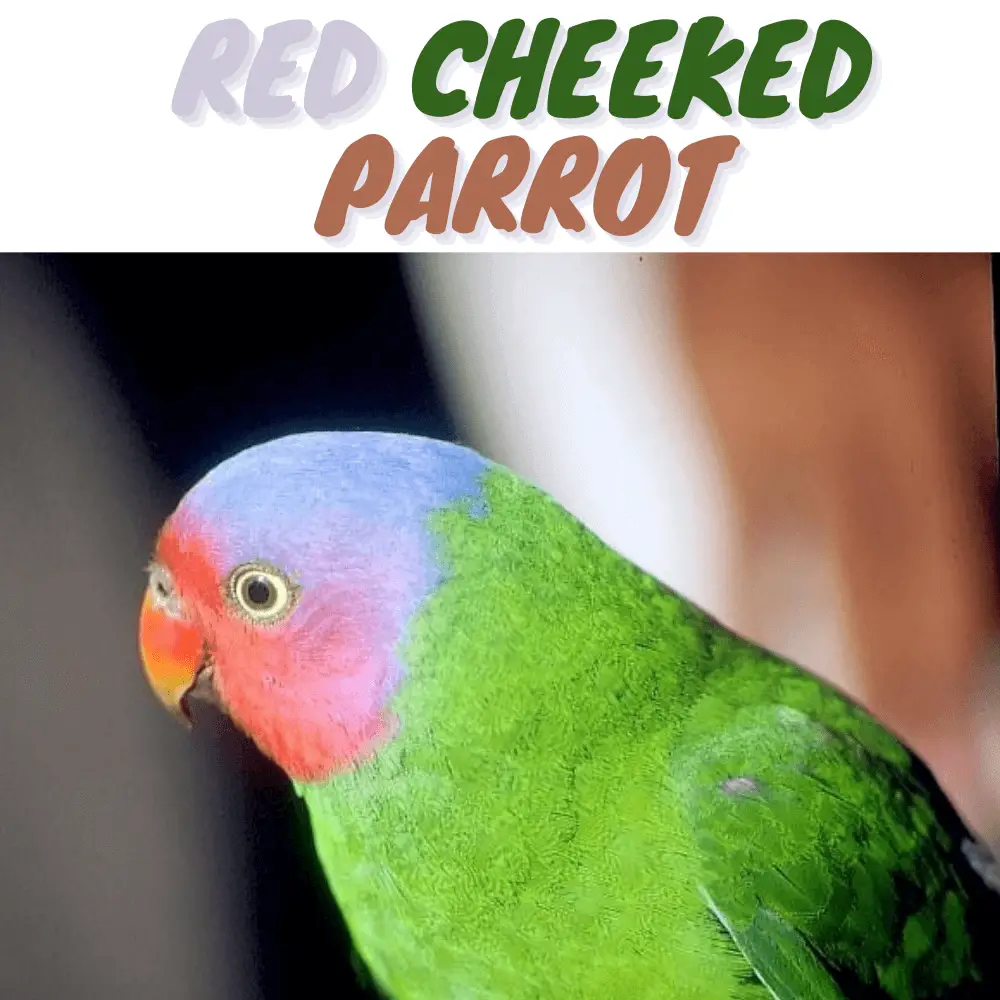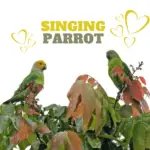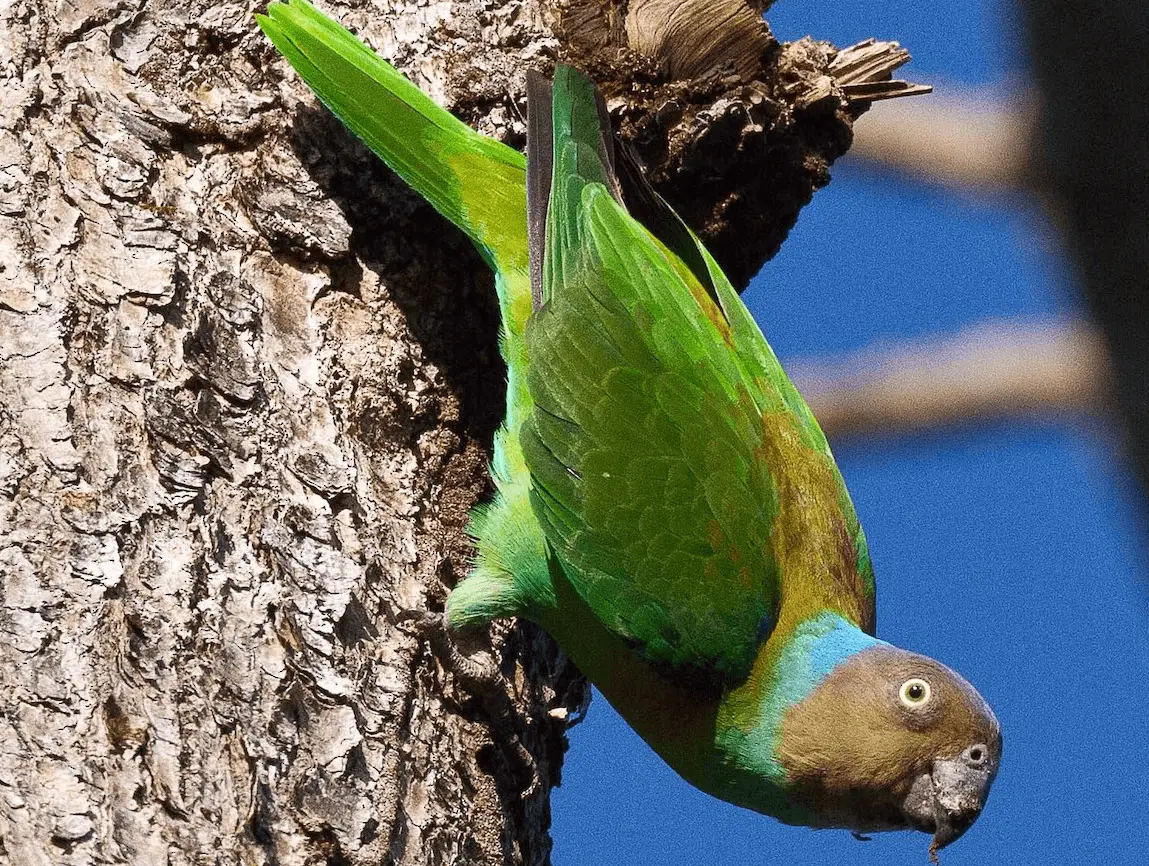
Red Cheeked Parrot 21–27 cm; 130–180 g. Green above, yellowish-green below; upper mandible red, lower black; head red except mid- to hind crown pale violet-blue; dull red stain on median wing-coverts; underwing-coverts blue.
Female has entire head dusky brown, with the brownish-grey bill. Immature has a green head with brown tinges, a dull bill. Race floresianus darker with violet extending onto nape; cyanicollis
with long blue-collar; obiensis with wider blue-collar, back brownish; rhodopsin large, dark; exploratory like rhodops but a female with paler forecrown; keyensis large and yellowish, with paler tail; timorlaoensis
similar but smaller; aruensis like floresianus but paler; orientalis similar but a paler violet crown; sudestiensis also similar but yellowish, without brown wing-coverts; cyanicarpus with mauve-violet on the face, blue edge to wing;
minor like aruensis but back brownish; jobiensis similar but back more reddish; mysoriensis also similar but violet-blue extends over hindneck and red over throat; pucherani
Systematics History
Editor’s Note: This article requires further editing work to merge existing content into the appropriate Subspecies sections. Please bear with us while this update takes place.
Red Cheeked Parrot Race exploratory rather poorly differentiated, maybe better synonymized with rhodopsin. Proposed races sumbavensis and tjindanae are synonyms of floresianus; stresemanni is included within rhodopsin. Seventeen subspecies were recognized.
Subspecies
Geoffroyus geoffroyi cyanicollis Scientific name definitions
G. g. cyanicollis+1
Distribution
Geoffroyus geoffroyi obiensisScientific name definitions
Distribution
Geoffroyus geoffroyi rhodopsScientific name definitions
Distribution
Geoffroyus geoffroyi exploratorScientific name definitions
Distribution
Geoffroyus geoffroyi keyensisScientific name definitions
G. g. keyensis
Distribution
Geoffroyus geoffroyi floresianusScientific name definitions
Distribution
Geoffroyus geoffroyi geoffroyiScientific name definitions
G. g. geoffroyi+1
Distribution
Geoffroyus geoffroyi timorlaoensisScientific name definitions
Distribution
Geoffroyus geoffroyi pucheraniScientific name definitions
Distribution
Geoffroyus geoffroyi minorScientific name definitions
Distribution
Geoffroyus geoffroyi jobiensisScientific name definitions
Distribution
Geoffroyus geoffroyi mysorensisScientific name definitions
G. g. mysorensis
Distribution
Geoffroyus geoffroyi orientalisScientific name definitions
Distribution
Geoffroyus geoffroyi sudestiensisScientific name definitions
Distribution
Geoffroyus geoffroyi cyanicarpusScientific name definitions
Distribution
Geoffroyus geoffroyi aruensisScientific name definitions
Distribution
Distribution
Editor’s Note: Additional distribution information for this taxon can be found in the ‘Subspecies’ article above. In the future, we will develop a range-wide distribution article.
Habitat
Lowlands generally to c. 800 m, sometimes higher (e.g. 1400 m, Flores and Lombok, and 1440 m, Buru), in primary and secondary wet and monsoon forest, being much less frequent in open habitat,
but in Lesser Sundas and on a few other islands seems to be commoner in the drier open coastal country including savanna woodland, coconut plantations as well as gardens, mangroves, nypa forest, freshwater swamp- and dryland forest and small offshore islands.
Movement
Substantial daily flights are made, but no hard evidence of seasonal movements.
Diet and Foraging
Seeds, nuts, fruits, berries, flower buds, blossoms are all recorded, but seeds within fruit, such as Eucalyptus papuana, Casuarina papuana, and Alpinia, appear important; also seen taking the fruit of the savanna tree Antidesma gaisambulla and Ganophyllum falcatum, and mistletoes.

Red Cheeked Parrot
Sounds and Vocal Behavior
Very vocal. Vocabulary includes a wide variety of Red Cheeked Parrot calls, e.g. nasal screeches repeated at a constant pace, whistles on an even pitch of which some are quite melodious and others sound like a horn, as well as various squabbling phrases.
Breeding
Apr–Aug in Lesser Sundas; Feb in NW New Guinea; Oct in NE New Guinea; Apr and Oct-Dec in S New Guinea (probably in most of the year throughout the island); Aug–Dec in Australia.
Red Cheeked Parrot Nest in a hole excavated by a Red Cheeked Parrot female in dead trunk or branch, 4–25 m up; on Sumba keeps apart from nesting associations made by other psittacids;
in Australia noted to nest often at the forest edge, or in Melaleuca or Pandanus woodland adjacent to the rain forest. Red Cheeked Parrot Eggs 3; incubation by the female; young stay with parents perhaps into the second year, possibly assisting at the nest.
Conservation Status

Red Cheeked Parrot Not globally threatened. CITES II. Common to abundant throughout much of range; estimated at 30 birds/km² in one area of New Guinea, and at 80 birds/km² on Halmahera.
Common on Sumba, Bacan, Obi, and the coast of Seram, less so in interior hills, and this diminution of numbers with elevation applies apparently throughout the range. Moderate numbers throughout Buru.
The population of race aruensis in N Australia is very restricted and feared likely to suffer from loss of suitable old nest trees through late dry-season fires.





















